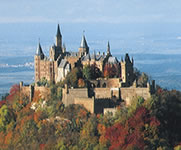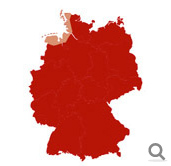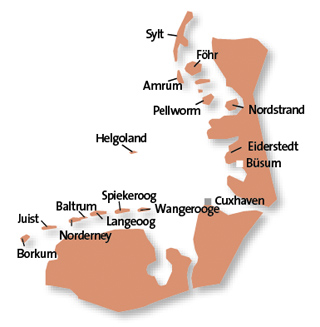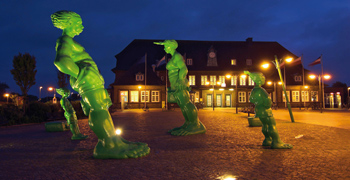
Historical Towns
- Historical towns in Brandenburg
- Cathedral Towns and Cities in Saxony-Anhalt
- The innovative Anhalt-Wittenberg Region
- Enchanting towns in the Harz
- The beautiful towns and cities in Saxony
- Towns and cities of culture in Thuringia
- Beautiful towns of Franconia
- East Bavarian traditional towns
- Alpine towns in the Allg�u
- The eastern Akpine Foothills and their towns
- Towns and villages in the western foothills of the Alps
- Mediterranean towns on Lake Constance
- Towns in the Swabian Alb
- Unspoilt towns in the Black Forest
- Towns for refined tastes in the Heilbronner Land
- Towns in the Odenwald
- Wine towns in Rheinhessen
- Saarland, a region of contrasts
- Romantic towns in the Hunsr�ck and Nahe Regions
- Idyllic towns and villages in the Moselle Region
- The Ahr Rhine Eifel holiday region
- Wine towns on the Romantic Rhine
- Modern towns and cities in the Bergisches Land Region
- The Lahn Valley and its fairytale towns
- Historical towns in Kurhessisches Bergland
- Sauerland's scenic towns
- Fairytale towns in the Weserbergland Hills
- Majestic towns in the M�nsterland Region
- The nine stars of Lower Saxony
- North and East Frisian Islands
- Vibrant Schleswig-Holstein
- Maritime towns along Mecklenburg's Baltic Coast
- Historical Hanseatic Towns
- Germany's Baltic Sea Islands
- The Mecklenburg Lakes
Contact and information
Tidal waters and romantic lighthouses Germany's `floating dreams'

Föhr
The breakers lap gently at the island's shores. Wyk, the largest town on Föhr, is relatively young yet at the same time one of the oldest certified resorts on the North Sea coast. Each year, the small resort attracts visitors with readings at the Summer of Literature and seduces them with the Musik am Meer music festival. The people of Föhr owe their prosperity to whaling, which brought fortune to the island in the 17th century. The legacy of this heyday can still be seen today in the churches, sailors' cemeteries and the eleven Frisian hamlets with their perfectly preserved centres.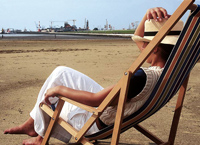
Norderney
The list of summer visitors to Norderney reads like a who's who of history. Artists, kings and statesmen all followed the example of George V of Hannover, who discovered the East Frisian island as a spa and seaside resort in the early 19th century. He often visited with a vast entourage in tow, establishing Nordeney's reputation as the St. Moritz of the North. The museum by the harbour was built by the German Maritime Rescue Service as a tribute to the island's lifeboat crews. Norderney is the only East Frisian island which still has a working windmill. Now a listed monument, it goes by the name Selden Rüst, which means `rarely at rest'. Cycling or hiking are the easiest ways to explore the island. With an expert guide, you can even venture out onto the mudflats.Idyllic Sylt
Sylt is Germany's most northerly island and the largest of the North Frisian chain. With its charming villages, coastal mudflats, rust-coloured cliffs, flowering heathland and 40km sandy beach, it's a great place to relax or enjoy a long walk. The popular island enchants visitors with its crashing waves on the western side and tranquil Wadden Sea mudflats on the eastern side. With twelve little villages, it has all the ingredients for a holiday full of variety.Spiekeroog
Time goes no slower on Spiekeroog than anywhere else, but it sometimes feels that way. The residents have protected their `green island' against the invasion of motorised vehicles and have largely preserved a more leisurely way of life. This former pirates' lair is now a unique breeding ground for all sorts of rare birds. The historical Spiekeroog horse-drawn tram operates in the summer months. The Cemetery of the Unknown remembers the loss of an emigrants' ship in 1854, while the island's most monumental trophy is a sperm whale skeleton.The North Frisian Hallig islands
Known as `dreams floating on the sea', the North Frisian Hallig islands are a unique geological phenomenon. Thanks to the ebb and flow of the tides, they are island and mainland all rolled into one. When the tides are very high, these small, undyked elevations in the midst of the coastal mudflats are completely submerged. Only the manmade mounds on which the locals' houses are perched, remain above the water. The Hallig islands can be reached on foot on a guided tour of the mudflats.A fiery tradition
One of the popular traditions on the North Frisian islands is the Biikebrennen festival, whose sacrificial fires hark back to Nordic mythology. Every year, on 21 February, the North Frisian people light beacons along the coast. In pre-Christian times this was to honour the Germanic god of war, Odin, but over the centuries the significance of the fire-lighting changed. The islanders lit the beacons to bid farewell to departing whalers and sailors, or as navigational aids. They are also said to drive the winter away.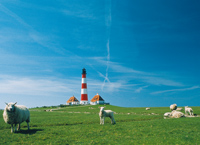
Protecting nature
Northern Germany is well-known for its wealth of flora and fauna and its fascinating landscape. The Lower Saxony Wadden Sea National Park was founded in 1986 to protect these treasures. Today this area has been granted UNESCO World Heritage status, along with the Wadden Sea in Schleswig-Holstein and the Netherlands. The bounty of the sea dominates menus here. Along with fish and shrimps, kale is also very traditional kale roulade or curly kale with sweet potato and pork. The region's traditional wine soup is still served on special occasions. The signature Frisian drink is the Pharisäer, invented by a wily farmer. Legend has it that at the end of the 19th century, the Nordstrand peninsula had an especially puritanical parish priest who forbade the consumption of alcohol in his presence. So, at a christening, the farmer added a shot of rum to the coffee and covered it with a layer of whipped cream. When the priest saw how merry the guests had become, he exclaimed angrily "You Pharisees!"Travel Planner
Select an option...
Romance and charm
If you have a head for heights, why not get married at the Westerhever, Hörnum/Sylt or Pellworm lighthouse and enjoy fabulous views of the beach and sea?
Food and drink
Sylt hospitality is widely renowned. The island is rightly regarded as something of a gastronomic hotspot, with several restaurants featuring in leading guides such as Michelin.
History and tradition
Bremerhaven Harbour Worlds is a new maritime tourist resort with a long list of exciting attractions including Klimahaus® Bremerhaven 8° Ost, the German Emigration Centre, the Zoo am Meer and the Mediterraneo shopping complex.
Nature and scenery
Idyllic beaches and open spaces are the hallmarks of Schleswig-Holstein's North Sea coast. Visitors can enjoy the sea and explore the coastal wetlands: total relaxation guaranteed.




